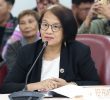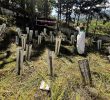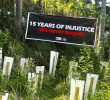By GRACE S. UDDIN | Davao Today
Davao City � He could hear the sound of his footsteps as he ran to escape his captors. His heart beat very fast. He went to their underground house, where they used to hold secret meetings against the Marcos government, to warn other activists to abandon the place. But men in uniforms captured him instead.
“It was just like in the movies,” recalls Bienvenido Lumbera, the National Artist for Literature, who was once a Martial Law survivor.
But that was 34 years ago.

Bienvenido Lumbera(davaotoday.com photo by Barry Ohaylan)
Now in his late 70s, Lumbera keynoted the gathering of activists in Davao city to revisit the darkest hours of Martial Law.
“To celebrate is to remember, to draw lessons from the experience and to affirm the same commitment,” said Sr. Celine Cajanding, convenor of Inpeace Mindanao.
Lourdeista Soberevega-Chan of the Ateneo de Davao University said it is important to remember Martial Law to remember the people who offered their lives as sacrifice.
“The most lasting legacy of Martial Law is vigilance and resistance,� said Sr. Cajanding. �It is vigilance and resistance that have made possible the emergence of the people’s movement for four decades.”
Cajanding said that under the present administration, it is still likely that the past will stick out its ugly head again.
“We have been traveling for four decades toward the goal of national liberation,� said Lumbera. �Four decades is a long time and now, we are eager to reach our destination.” He went underground in the 1970s along with other activists who wanted to put an end to the Marcos dictatorship. The Ipil Detention Center in Fort Bonifacio where he was detained for almost a year in 1974 is now dismantled.
Lumbera compared the people’s struggle for national liberation to a journey, by citing four landmarks: the First Quarter Storm of the 1970s, the Martial Law years, the EDSA revolt and the entry of the left-leaning partylist groups Bayan Muna, Anakpawis and Gabiela in electoral politics.
“The landmarks are assurance that travelers have progressed toward their final destination,” he said.
Lumbera said the First Quarter Storm is considered a major triumph because the crisis that sprang from the devaluation of the peso during the administration of former President Diosdado Macapagal exposed the truth of the American control over the Philippine economy and was met by protests from the people.
Different groups were formed, including the Kabataang Makabayan, among the youth; the Samahan ng mga Guro ng Pamantasan, among the teachers; the Samahan ng Makabayang Siyentipiko, among scientists; the Malayang Samahan ng Bagong Kababaihan, among women; the Panulat Para sa Kaunlaran ng Sambayanan, among writers; and Pasang Masda among jeepney drivers.
“It was from the ranks of the First Quarter Storm that the cadres of the movement were to come,” according to Lumbera.
He considered the declaration of Martial Law, considered one of the darkest periods of the Philippine history, as the second landmark.
“The word itself strikes fears in our hearts,� said Sr. Cajanding, an activist during the time. �For those who have lived to see the day, it was like being in a nightmare that went on for more than 15 years. For those who were still babies when it was declared, it was a period of growing up in social uncertainties; and for those who were born after the fall of the dictatorship, it provided a lesson and a reminder to pray, never again!” said Sr. Cajanding.
Lumbera recalled that during this period, the national democratic movement intensified political works, guided by the document, entitled “Our Urgent Task.” The New People’s Army (NPA) expanded in membership and the broad united front, the National Democratic Front (NDF) which brought together forces that fought against the dictatorship, was formed. �Marcos was the number one recruiter of the NPA,� added one professor, because it was the dictatorship that spawned discontentment among the people.
Lumbera considered the fall of the Marcos dictatorship, through the EDSA revolt, that ushered former President Corazon Aquino to power, as the third landmark. But he considered this landmark a problematic one.










